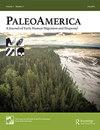Bayesian Revision of the Folsom Age Range Using IntCal20
IF 1.7
Q1 ANTHROPOLOGY
引用次数: 13
Abstract
ABSTRACT Folsom is an early Paleoindian archaeological tradition found in the North American West. Here we report new AMS radiocarbon dates for the Barger Gulch and Lindenmeier sites in Colorado along with unsuccessful dating attempts for Blackwater Draw, the Mitchell Locality, Shifting Sands, and Lipscomb on the Southern Plains. We applied Bayesian modeling using IntCal20 to our updated set of Folsom dates and estimate that the Folsom tradition lasted for a period spanning between 355–510 years at the 68 per cent credible interval or 325–650 years at the 95 per cent credible interval, starting sometime between 12,845–12,770 calendar years ago (cal yr BP) and ending sometime between 12,400–12,255 cal yr BP. Additionally, we model the spans of the start and end boundaries and find that both the adoption and abandonment of Folsom technology occurred over relatively short periods, less than 100 years and likely less than 50 years.使用IntCal20对Folsom年龄范围的贝叶斯修正
Folsom是在北美西部发现的一种早期古印度考古传统。在这里,我们报道了科罗拉多州Barger Gulch和Lindenmeier遗址的新AMS放射性碳年代测定,以及南部平原Blackwater Draw、Mitchell Locality、Shiving Sands和Lipscomb的未成功年代测定。我们使用IntCal20将贝叶斯建模应用于我们更新的Folsom日期集,并估计Folsom传统持续了355–510年(68%可信区间)或325–650年(95%可信区间),从12845–12770日历年前(cal-yr-BP)开始,到12400–12255 cal-yr BP结束。此外,我们对开始和结束边界的跨度进行了建模,发现Folsom技术的采用和放弃都发生在相对较短的时间内,不到100年,可能不到50年。
本文章由计算机程序翻译,如有差异,请以英文原文为准。
求助全文
约1分钟内获得全文
求助全文
来源期刊

PaleoAmerica
Earth and Planetary Sciences-Paleontology
CiteScore
3.70
自引率
0.00%
发文量
15
期刊介绍:
PaleoAmerica disseminates new research results and ideas about early human dispersal and migrations, with a particular focus on the Americas. It fosters an interdisciplinary dialog between archaeologists, geneticists and other scientists investigating the dispersal of modern humans during the late Pleistocene. The journal has three goals: First and foremost, the journal is a vehicle for the presentation of new research results. Second, it includes editorials on special topics written by leaders in the field. Third, the journal solicits essays covering current debates in the field, the state of research in relevant disciplines, and summaries of new research findings in a particular region, for example Beringia, the Eastern Seaboard or the Southern Cone of South America. Although the journal’s focus is the peopling of the Americas, editorials and research essays also highlight the investigation of early human colonization of empty lands in other areas of the world. As techniques are developing so rapidly, work in other regions can be very relevant to the Americas, so the journal will publish research relating to other regions which has relevance to research on the Americas.
 求助内容:
求助内容: 应助结果提醒方式:
应助结果提醒方式:


